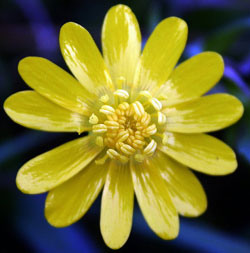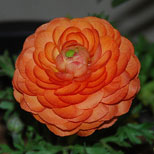The Ranunculus Flower

The beautiful green leaves look almost like celery and grow in mounds about 6-12in. across. In the spring, you’ll begin to notice beautiful flowers emerging from those 12-18in. stems from the bulbs you planted in the fall.
Some flowers can get up to 3-6in. wide and come in a variety of vibrant colors. You can purchase ranunculus bulbs in the fall at almost any nursery during mild-winter climates. However, on cooler days during the fall and in early spring, you’ll have to get them from mail-order catalogs.
 Scientific Name
Scientific Name
The ranunculus flowers are part of the Buttercup family and are known for their bright colors and multi-layered petals that almost look like a thin layer of crepe paper.
This special flower thrives in both southern and western gardens. However, they make the perfect container plant almost anywhere. They’re also the perfect choice if you want long-lasting cut flowers.
 Geographic Origin
Geographic Origin
Ranunculus Glaberrimus
Also known as the Sagebrush Buttercup, this small plant can be found near the interior of western North America, central British Columbia, southern Saskatchewan, northeastern California and northern New Mexico. Talk about spanning the globe! Habitats for this plant are around sagebrush and junipers.
This herbaceous perennial only grows 5-26cm. tall. It has oval shaped leaves some with rounded teeth edges. Sagebrush buttercups are bright glossy flowers with five petals, some with ten or more. This is one of the first flowers among a select few to bloom after the winter snow melts.
 Description and Characteristics
Description and Characteristics
Ranunculus Bulbosus (St. Anthony’s Turnip)
This isn’t an ordinary flower. It’s actually known as a perennial weed. It doesn’t look like a weed though. The ranunculus bulbosus is actually a beautiful shiny yellow flower that has 5-7 petals. This flower blooms from April-July.
The plant is also called the bulbous buttercup. That name comes from a bulb-like stem found underground just below the surface of the soil. When the plant dies from the summer heat, the underground stem survives through the winter.
Uses of Bulbous Buttercup
- This buttercup like many others contains glycoside ranunculin. Livestock don’t go near it in its fresh form. However, after it dries, the toxin is lost and the hay that contained it is now safe for animals to eat.
- This plant is also used for medicinal purposes in homeopathy as an herbal remedy. It’s used for treating blistering of the skin for most part during the summer.
 Meaning
Meaning
The blue ranunculus is a rare, beautiful, but dangerous flower. Every part of this plant is poisonous if ingested and your skin may get irritated or you may have an allergic reaction if you handle the plant. So make sure you wear gloves when working in the garden.
 Cultivation and Care
Cultivation and Care
Blue ranunculus bulbs should be spaced 6-9in. apart in full sun to partial shade. This particular ranunculus grows to be anywhere from 6-18in. tall. Its beauty is like no other of the buttercups, it’s violet/lavender when it blooms. Its bloom time is between late winters-early summers.
This plant has deciduous foliage and the flowers are good for cutting and for use in growing containers. This plant primarily grows in Oakland and California.
Care Details
- Water Regularly
- Don’t overwater
- Needs consistently moist soil
- Don’t let the soil dry out between watering
 Diseases and Pests
Diseases and Pests
Poisonous Properties
Every part of this plant is poisonous when it is fresh. Heat and drying can destroy the toxins. Blistering of the skin is caused by the strong acrid juice coming from the plant. If you ingest it, your mouth will burn; you’ll have abdominal pain, vomiting and other health issues.
Ranunculus Repens
Otherwise known as the Creeping Buttercup, this flowering plant is native to Asia, Europe and northwestern Africa. It’s also known as Sitfast and Creeping Crowfoot.
This herbaceous perennial grows to be about 50cm tall. Its leaves and stems have fine little hairs and bright yellow flowers on them with five petals. This buttercup can be found in pastures and fields. When cultivated, it’s primarily an ornamental plant.
Just like the other buttercups this too is poisonous. When it’s dried with hay, it loses its poison and its taste is acrid. Cattle stay clear of it. Therefore, this plant takes advantage of the ground already cropped in order to spread its stolons.
Creeping buttercup can also spread to hay being transported. This plant can cause blistering of the skin if touched.
Pests & Diseases of the Ranunculus
- Leafminers- Flies, moths and beetles eat the foliage causing it to dry and turn white or brown.
- Mites and Viruses- these suck the sap out of the plant which stunts the growth and leaves yellow/black/brown spots.
- Snails and Slugs- slugs eat different shaped holes into the already bloomed plants if the temperature stays above 40 degrees Fahrenheit. Snails eat between spring and fall after sunset when it’s wet.
- Rust- yellow, brown, or orange spores develop on stems and leaves causing plants to wither and die.
- Mildew- Produces discolored areas on the tops of leaves or bulbs. Leaves purplish or fuzzy white fungi underneath. This grows on the surface of the leave and affects the plant.
Please read the warnings of any of the buttercup plants as they are all poisonous. You can still plant them as long as you wear gloves and simply don’t ingest them. They really do add to your garden. You just have to be smart in the care of the plant. Do so and they really will accent any décor beautifully.
 Uses
Uses


